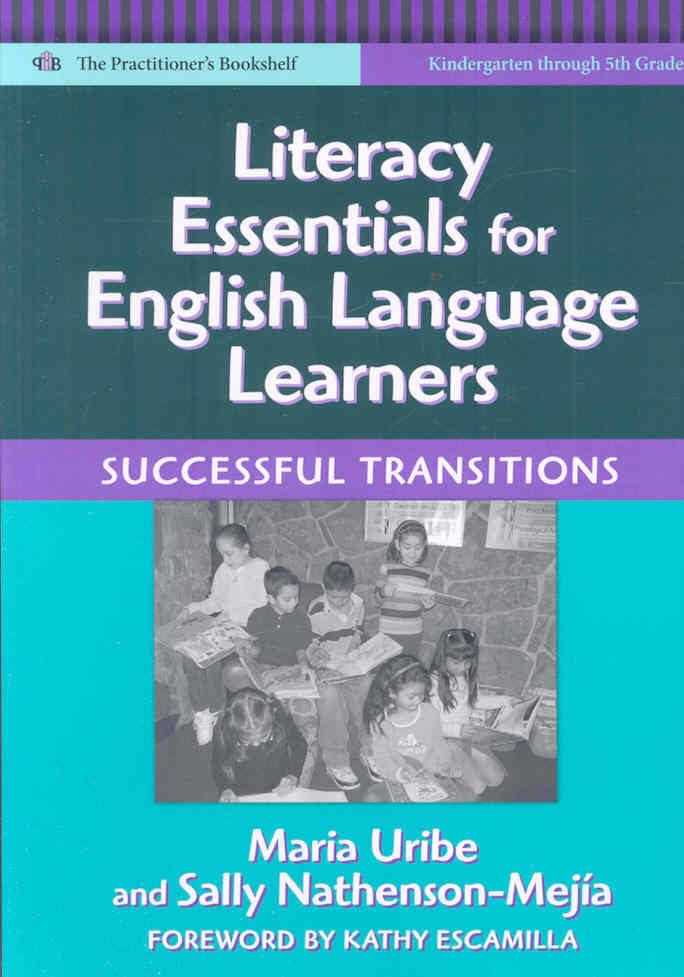Originally published 2008 | ||
 | ||
Editors Sally Nathenson-Mejía, Maria Uribe | ||
Literacy Essentials for English Language Learners, by Maria Uribe and Sally Nathenson-Mejia, is a practitioner book to help kindergarten through fifth grade teachers with English Language Learners (ELL) in their classroom. The book, as a whole, gives advise about: creating a supportive environment for the students, how to have successful listening, reading and writing lessons with English Language Learners. There are many lesson plans in the book that helps guide teachers through the process of having a successful environment for ELL students.
Contents
- Chapter 1 Background Knowledge Its Role in English Language Learning
- Chapter 2 Instructional Environment Creating Support for Learning Language
- Chapter 3 Interactive Read Alouds Hearing Language
- Chapter 4 Shared Reading Learning Through Language
- Chapter 5 Guided Reading Learning About Language
- Chapter 6 Writing Instruction Developing Literacy
- Conclusion
- Pros
- Cons
- References
Chapter 1: Background Knowledge: Its Role in English Language Learning
This chapter is all about background knowledge, from the point of view of the students. It helps give the reader the ELL students perspective and makes them see how difficult it can be for an ELL student in the classroom. There are quizzes for the reader to take that have to do with different cultures in different countries. The book does this to set up the reader to fail, in the sense to make them realize that if they were in the ELL students "shoes" they would feel disconnected and not have the knowledge that students born in America would have.
Chapter 2: Instructional Environment: Creating Support for Learning Language
This chapter talks about how to plan, as a teacher, for reading and writing in a classroom with ELL students and native English language learners. It discusses how to effectively group students, so that they get the most out of working in a group together and learn more from each other.
Chapter 3: Interactive Read Alouds: Hearing Language
Read Alouds are discussed, along with how to successfully teach them in the classroom. Read Alouds are meant as "a planned oral reading of a book or print excerpt, usually related to a theme or genre of study. the read aloud can be used to engage the student listener while developing background knowledge, increasing comprehension skills, and fostering critical thinking," (38).
Chapter 4: Shared Reading: Learning Through Language
Through shared readings, where ELL students are joining with the teacher to read from the shared text, they are "exposed to the five reading components--Vocabulary, phonics, phonemic awareness, fluency, and most important, comprehension," (56). The chapter also discusses successful ways to do this with K-2 grade ELL students, 3-5 grade ELL students and students with Native Language instruction. It also provides lesson plans, so that the teacher can have a successful shared reading environment in the classroom with ELL students.
Chapter 5: Guided Reading: Learning About Language
The practitioner book states that the goal for guided reading "is small-group instruction that builds on what students have learned from read aloud and shared reading" and "a small number of ELL students need to be grouped together to meet their specific reading needs," (71). The chapter covers how to group ELL students, with or without Native Language instruction, and how to effectively choose texts for the guided reading.
Chapter 6: Writing Instruction: Developing Literacy
This chapter defines what ELL students and that is "vocabulary and print knowledge, (linking know meaning to new words, both oral and written), syntax (figuring out how to put the new words together), and pragmatics (the purposes and expectations in the new culture)," (93). While the chapter goes into greater definition of these needs, it also covers: why it is important to teach nonfiction writing, how to connect the reading and writing process, how to instruct Native Language writing and how to inform instruction from assessing writing.
Conclusion
This is the last part of the practitioner book and its main purpose is to remind the reader about the importance of teaching to ELL students in a manner that they will learn from. It also discusses how to address the ELL students in the classroom and the importance of making sure that "literacy instruction in the classroom should reflect the communicative functions of language and create the kinds of social contexts and conditions in which literacy can and will flourish," (118).
Pros
There are many pros from this practitioner book. Those include: ways to make successful lesson plans for the classroom and how to teach ELL students in a manner that they will learn English successful and thrive when they leave school. While it does all this, it also explains why it is important to teach these ways and how it can be successful if followed and damaging if not followed.
Cons
There were not many cons to the book but the one common thread, that could disengage the reader, was that it was very repetitive. The authors would repeat the same concept or idea over and over. This was the only major con of the practitioner book.
